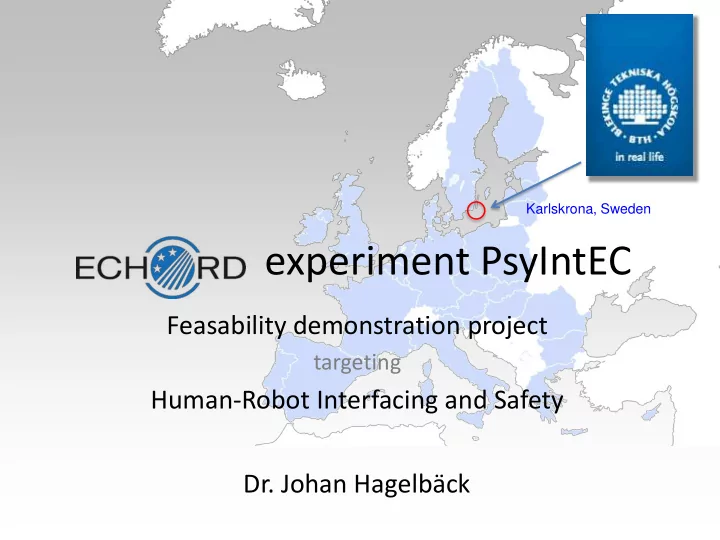

Karlskrona, Sweden experiment PsyIntEC Feasability demonstration project targeting Human-Robot Interfacing and Safety Dr. Johan Hagelbäck
Project idea • Joint human-robot work cell. • A human co-worker collaboratively solves a reference task with a robot. • Measure affective states in the human co-worker, • … and compare to doing the same task alone or collaboratively with another human. • … and use that knowledge to adapt robot behavior, biofeedback (ongoing).
• Feasability Demonstration. • Development of a workcell for measuring affective states in HRI. • Experiments to build a human affect model in HRI. • Development and demonstration of biofeedback (ongoing).
Collaborative task • Towers of Hanoi • Single-player game, two-player game by using turn-taking. • Relatively easy to understand for (most) participants, but requires some thought to complete.
Psychophysiology sensors Sensor Measure EEG 8 electrodes in Electrical activity in the brain. frontal lobe ECG Heart rate. EMG corrugator Facial muscle activity at the eyebrow. EMG zygomatic Facial muscle activity at the corners of the mouth. GSR Skin conductance in the palm.
Affective states Arousal High Happy Fear Frustration Pleasant Valence Displeasure Pleasure Sad Satisfied Low
Affective states Arousal High Happy Fear GSR ECG/HR EEG Frustration Pleasant Valence Displeasure Pleasure EMG corrugator EMG zygomatic (EEG) Sad Satisfied Low
Adaptive robot behavior Arousal High Happy Fear If this is detected Frustration Pleasant Adapt robot behavior Valence to move here Displeasure Pleasure Sad Satisfied Low
Hardware setup
Software setup
Work scene
Work scene
Experiment • Four experiment conditions:
Experiment • Three games per condition (in total 12 games) • Psychophysiological data from sensors • Geneva Emotion Wheel (GEW) • Subjective feelings • Video • 70 participants • 90 mins each
GEW
DATA PROCESSING
Removal of recording errors • Data points out-of-bounds of value range for a sensor were removed. Sensor Amount of data removed EEG 17.7% ECG 21.4% EMG corrugator 5% EMG zygomatic 13.2% GSR 6.1%
Cut data into segments Recorded data Baseline Game 1 Game 2 Game 12 … Segment Segment Segment Segment • Mean • Min • Max • Standard deviation
Baseline Removal BL = mean value of baseline segment • Mean - BL • Min - BL • Max - BL • Standard deviation
Average over all participants • Game 1 Condition 1 Participant n 1 is averaged with Game 1 Condition 1 Participant n 2 • Different order for participants … N=70 • Mean: mean [ (mean-BL) 1 , (mean-BL) 2 , … , ( mean-BL) 70 ] • Min: Global minimum (data-BL) n • Max: Global maximum (data-BL) n • Standard deviation: mean [ std 1 , std 2 , …, std 70 ]
Data Values
Comparison between Conditions 1. Compare mean values between the different conditions: • Single Human, SH • Human-human, HH • Human-Robot, HR • Human-Robot unpredictable, HRu 2. See if there are any noticeable differences in activation with, our without robots.
RESULTS
EMG corrugator Good indicator of negative valence (displeasure)
EMG zygomatic Good indicator of positive valence (pleasure)
GSR Good indicator of arousal
EEG Good indicator on mental activity and attention
Heart Rate Good indicator of arousal, especially for negative valence (displeasure)
Statistical Analysis • One-way analysis of variance (ANOVA), α = 0.01 Sensor Significance (* is significant) EEG 0.716 Heart Rate 0.001* EMG corrugator 0.564 EMG zygomatic 0.405 GSR 0.000*
Statistical Analysis • Post-hoc analysis using Fisher’s least significant difference, α = 0.01 HH HR HRu GSR SH 0.001* 0.348 0.062 HH 0.000* 0.000* HR 0.345 Heart Rate SH 0.393 0.022 0.000* HH 0.146 0.003* HR 0.122
CONCLUSIONS
Is there a difference between with or without robots? • EMG sensors show a clear increase in activation for positive and negative valence in HRu. • Very small differences for HR compared to without robots. • No clear differences in arousal. Heart rate indicates decreased arousal with robots. • Increased mental load and attention for all collaborative tasks rather than with/without robots.
Limitations 1 Data for Game n 0 3 mins • Emotions are short-lived affective states. • Lots of things can happen during a game that lasts 2-3 mins. • Mean values fail to detect spikes. • Analysis on shorter time segments, for example per move, can give better results and give insight into contradictions.
Limitations 2 • EMG activity increases progressively from the beginning to the end of a task. • A linear regression baseline could give better, more significant results compared to a constant baseline.
Biofeedback system (in progress) GSR Runtime reading of ECG signals. EMGz EMGc EEG Time
Biofeedback system (in progress) Evaluation points GSR ECG EMGz EMGc EEG Time GSR module Signal features for last 15 sec Heart Rate module window are fed to modules which EMG zygo module can detect: Arousal EMG corru module Positive valence EEG module Negative valence Cognitive load
Biofeedback system (in progress) Evaluation points GSR ECG EMGz EMGc EEG Time GSR module Heart Rate module Adaptive baselines EMG zygo module are taken into EMG corru module consideration. EEG module Baselines Repository
Biofeedback system (in progress) Evaluation points GSR ECG EMGz Aroused & Pos Valence? EMGc EEG Aroused & Neg Valence? Time Not Aroused? GSR module Rule-based Heart Rate module EMG zygo module Evaluator EMG corru module EEG module Baselines Repository
Biofeedback system (in progress) Evaluation points GSR ECG EMGz EMGc EEG Time Decision: 1. Max speed (70%) GSR module 2. Medium speed (40%) Heart Rate module 3. Slow speed (10%) EMG zygo module Evaluator EMG corru module EEG module Baselines Repository
Thanks for the attention! PsyIntEC team Dr. Johan Hagelbäck, project manager Dr. Stefan Johansson, senior researcher Prof. Craig Lindley, external adviser Olle Hilborn, Ph.D. student Petar Jercic, Ph.D. student Wei Wen, Ph.D. student Johan Svensson, lab engineer and developer Blekinge Institute of Technology Karlskrona, Sweden www.bth.se/com/cogneuro
Recommend
More recommend